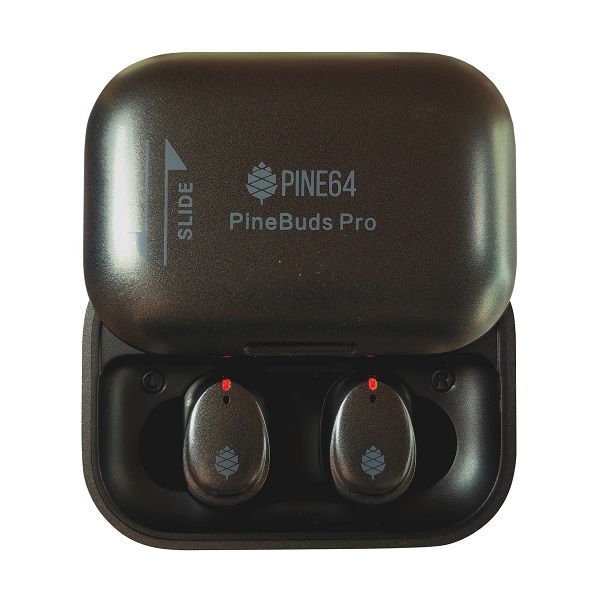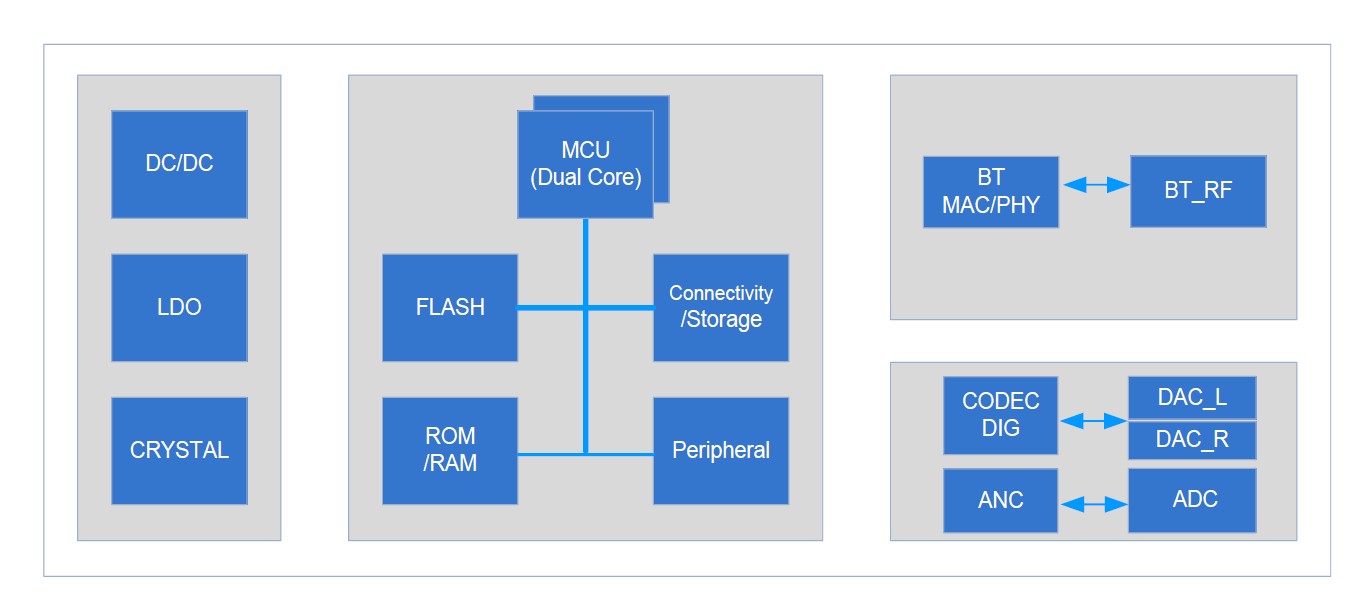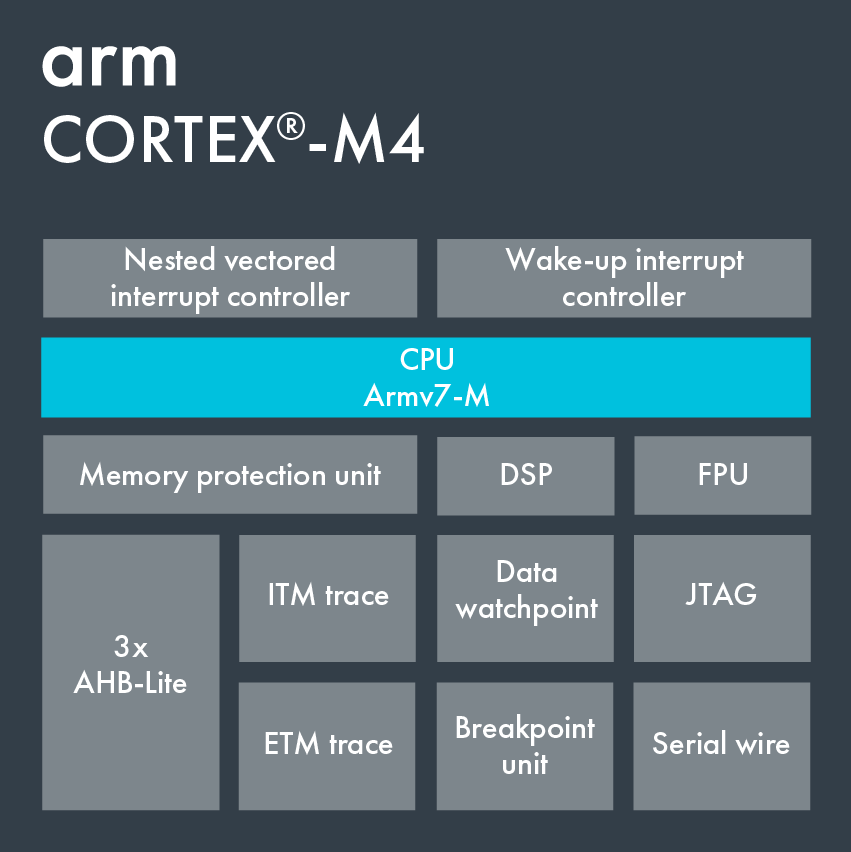PineBuds Pro
The PineBuds Pro are open firmware capable ANC wireless earbuds. Some of the notable features include their light weight, 3 Microphones, ANC (Active Noise Cancellation), ENC (Environment Noise Cancellation) and high fidelity 6mm speaker. It is a fully community-driven side-project which anyone can contribute to, allowing you to keep control of your device even though hardware is proprietary.
Short overview / Specifications
Dimensions:
- Earbud: WIP
- Charging case: 70 x 50 x 35mm (unconfirmed)
Weight:
- Earbud: 5g
- Charging case: 65g
IP Rating of Earbuds: IPX4
Dynamic transducer (speaker): 6mm
Microphone: 3 – FeedForward, FeedBack, Talk
System on Chip (in each earbud): BES 2300YP
- CPU: Dual-core 300MHz ARM Cortex-M4F
- ROM: 448KB
- SRAM: 992KB
- BT shared SRAM: 64KB
- Flash: 4MB (Endurance erase cycles: >500)
Communication:
- Bluetooth: Bluetooth 5.2 dual-mode compliant
- USB: USB to dual UARTs at charging case
Battery:
- Earbud: Built-in LiPo 3.7V 40mAh
- Charging case: Built-in LiPo 3.7V 800mAh
Port:
- Earbud: 4 pins
- Charging case:
- 4 pogo pins
- USB type-C port 5V 500mA
Software
Firmwares
Firmware images
Flash back factory default firmware using Windows based utility:
- PineBuds Pro Windows based programmer utility user manual
- PineBuds Pro Windows based programmer utility
- PineBuds Pro factory default firmware build
- PineBuds Pro factory default OTA build
SDK release
Introduction
General information and tips about PineBuds Pro.
Buttons/touch sensors
Buds
One capacitive touch sensor is located on the outward facing surface of each bud near the logo.
Charging case
Charging case have a reset button in center under the lid which is hooked to ThinkPlus Semi SY8821 integrated circuit and that button reset it from the safety off mode.
Cleaning
PineBuds Pro only have IPX4 rating, so they are only splash-proof and cannot withstand immersion in water. Clean the charging case inside and out with a damp microfiber cloth. Inside, be careful near the pogo pins! The cloth easily sticks to them and may tear them. You can use a microfiber cloth at the end of a stick to immerse of the buds, but a cleaning tool made for this can help. When cleaning the buds, carefully remove the tips, place the buds on a damp microfibre cloth and one by one wipe it from all sides. Be careful with the protective mesh. If there is dirt in the mesh, you can carefully clean it with the brush of the previously mentioned tool. Wash the tips with soap and water, but be careful, they easily drip from your hand to drain. After drying them, carefully put them back to the buds.
You need:
Spare parts
Coming soon.
Accessories
Please help to review and edit this page or section. Information are subject to change.
Ear tips
TODO
Strap for buds
Although PineBuds Pro, "true wireless", earbuds are comfortably light and stay in ears better than wired ones (when nothing tug them from your ear), they can still did it, for example, during sports. Because they are completely non-wired, it also means that they will then drop directly to the ground and may break. That's why it might make sense to use a strap like this in sports. We are trying make strap for PineBuds Pro.
Strap with 3.5mm AUX connector
Each bud has pins through which is UART connection. When we find or make a strap for PineBuds Pro we can add wiring inside it and put PCB in the middle that receives analog signal with the 3.5mm AUX connector and feeds it to the buds.
Silicone case
Goal is to make a silicone case like this for PineBuds Pro.
"Design a mold, use a hobby 3D printer to manufacture it, then fill with silicone." (source)
"You can find a local hackspace or makerspace. Or you can use one of the many services available via the Internet who can print a model for you. Just design, upload, and pay." (source)
"The only one I know of is "https://www.pcbway.com/rapid-prototyping/injection-molding/"" (source)
Disassembly / Assembly
Please help to review and edit this page or section. Information are subject to change.
Disassembly steps
Bud
Charging case
- First open the lid and then try to press the case from the front edge with a plectrum or a thin card. There are two clips on each side. Soon the case will snap open.
- Carefully unscrew and remove the PCB from the case.
Assembly steps
Bud
Charging case
- Screw the PCB back into the place.
- There is plenty of space, glue the coil to the bottom of the case.
- Close the charging case.
Wireless charging
PineBuds Pro doesn't have wireless charging by default, but you can add it. However, you need to know how to disassemble the charging case and solder bunch of SMT components to the PCB.
Pine originally planned to have wireless charging for the PineBuds Pro, but apparently for cost reasons they decided to cancel it. However, they left footprints on the PCB for wireless charging component. They also desiged COPO CP2021 component to be used. You also need a bunch of other components, such as resistors and of course electromagnetic coil. The places intended for the components, the footprints, are made for SMT (also called SMD) components. That means you need a hot air soldering station and experience.
Required tools:
- Picks/thin cards
- Screwdriver
- Hot air soldering station
- Tweezers
- Solder
- Flux
- Glue
Required components:
- COPO CP2021
- WIP
Work steps:
- First open the lid and then try to press the case from the front edge with a plectrum or a thin card. There are two clips on each side. Soon the case will snap open.
- Carefully unscrew and remove the PCB from the case.
- Solder the necessary components to their respective footprints, use the PineBuds Pro Charging Case Schematic/COPO CP2021 2.5W Qi Wire Power Receiver Datasheet (below).
- Screw the PCB back into the place.
- There is plenty of space, glue the coil to the bottom of the case.
- Close the charging case.
Revisions
Please help to review and edit this page or section. Information are subject to change.
Second revision
Changes from the first revision
- The chargin case's battery is hot glue snotted in place instead of taped.
First revision
Known issues
- No padding one side of the battery in the charging case. In one reported case charging case has started to smell burnt after being dropped. The battery hit to the USB Type-C connector's corner and the battery was damaged. If this happens to you, replace the battery with a new one immediately! Adding a padding around the battery as a precaution is advised.
SoC and Memory Specification
The PineBuds Pro's buds are based on the BES 2300YP.
SoC architecture:
- CMOS Single-chip Fully-integrated RF, PMU, Audio CODEC and Cortex-M4F CPU
- Memory Features:
- 4MB Serial Flash On-chip for Custom Program
- Internal ROM 448KB for critical constants and code
- Internal SRAM 992KB for critical data and code
- BT Features:
- Bluetooth 5.2 dual-mode compliant
- Profiles: A2DP, AVRCP, HFP
- Audio Codecs: SBC, AAC
- Audio Features:
- Support BES Intelligent Bluetooth Retransmission (IBRT)
- Support FF/Hybrid ANC
- Dual MICs noise reduction
- Echo Cancellation
- Support low power voice activity detection
- Multi-band EQ and Bass enhancement
- Support Active Crossover
- Support TWS
- HiFi Stereo Audio DAC: 120dB SNR, 110dB DNR
- HiFi Stereo Audio ADC: 100dB SNR
- Sample rates from 8 kHz to 384 kHz
- Support dual/single Mic noise suppression
- -45dB attenuation nominal 50-200Hz
- -55dB max attenuation @150Hz
- Support ambient awareness
- Support talk through
- 24-bit audio processing
- PMU Features
- 3.1V-5.5V Input for VBAT
- Internal LPO for low power mode.
- DCXO with internal oscillator circuit
- Internal temperature sensor
Information, Schematics and Certifications
The charging case's input power: DC 5V @ 0.5A USB Type-C
Documents:
Schematics:
Certifications:
- PineBuds Pro CE EMC Certificate
- PineBuds Pro CE RED Certificate
- PineBuds Pro FCC Certificate
- PineBuds Pro ROHS Report
Datasheets for Components and Peripherals
BES 2300YP SoC information:
Charging case:
- ThinkPlus Semi SY8821 Datasheet in Chinese
- WCH Tech CH342DS USB to Dual Serial ports chip Datasheet
- COPO CP2021 2.5W Qi Wire Power Receiver Datasheet (Unpopulated)
EarBuds:



